For additional information relating to this article, please contact:
March 28, 2023BUSINESS OPENING AND CLOSING, DECEMBER 2022 Statistics Canada released updated data on monthly business openings and closures for December 2022. The data are seasonally adjusted.
Month-over-month (December 2022 vs November 2022, seasonally adjusted)
The number of active businesses in Nova Scotia decreased 0.13% from November to December 2022 (falling to 20,496 active businesses). The number of active businesses has been around 20,500 through 2022.
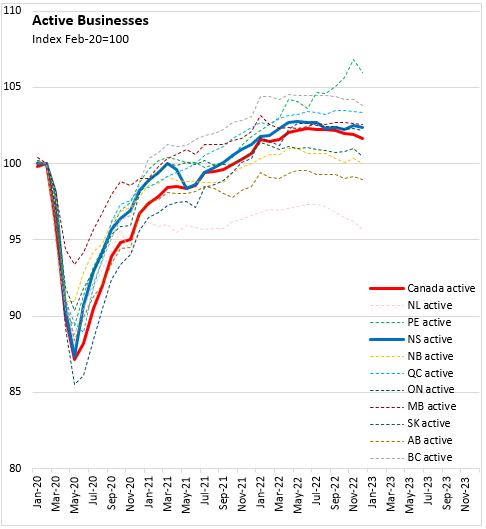
Nationally, active businesses declined by 0.26%. All provinces reported lower numbers of active businesses in December 2022 compared with November 2022. The largest decline was reported in Prince Edward Island (-0.83%).
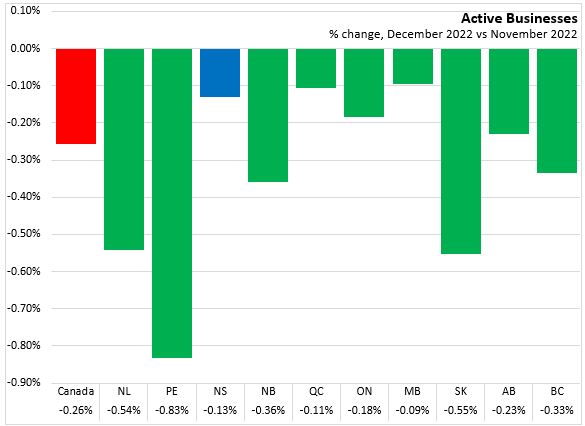
Year-over-year (December 2022 vs December 2021)
Compared with December 2021, the number of active businesses was up 1.1 % for Nova Scotia. Nationally, active businesses were 1.0% higher than in December 2021. seven provinces reported a higher number of active businesses compared with December 2021, with the largest increase in Prince Edward Island. Saskatchewan, Newfoundland and Labrador reported declines while New Brunswick was essentially unchanged.
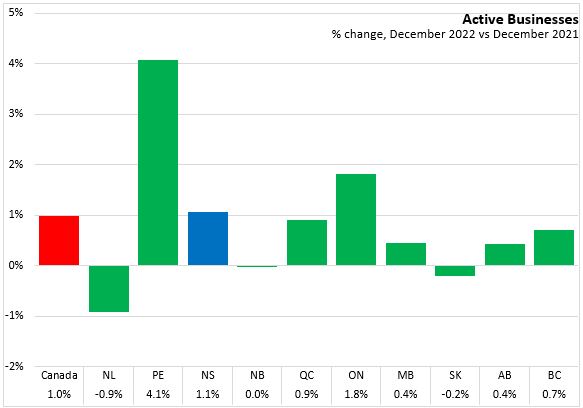
The number of active businesses in the Halifax and East Hants Census Metropolitan Area was up 5.8% from December 2021 to December 2022. However, the East Hants portion of the CMA was only added in June 2022, and this accounts for much of the growth compared with December 2021 (which did not include East Hants in the Halifax CMA).
Among CMAs, Belleville reported the largest decline of active businesses over the last year. The cities with the largest rises in the number of active businesses were Windsor and Peterborough.
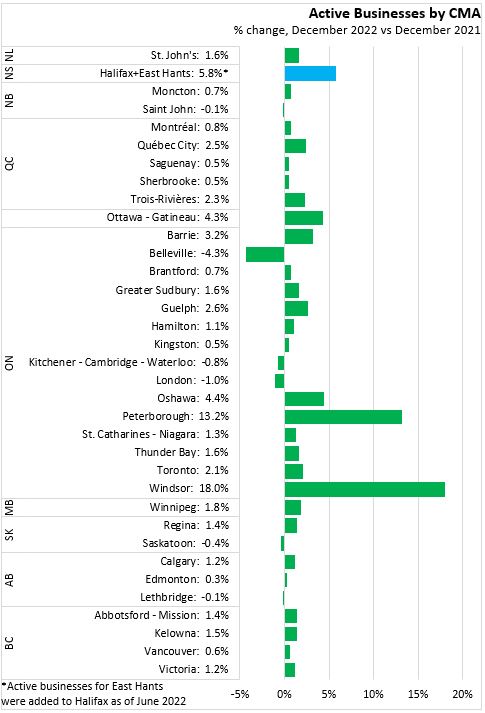
Compared with December 2021, the number of active Nova Scotia businesses in December 2022 was lower in forestry and fishing, manufacturing, wholesale trade, retail trade, transportation, information/culture, finance/insurance/management, arts/entertainment/recreation, and personal/repair services. From December 2021 to December 2022, there were notable percentage increases in the number of active businesses in utilities (starting from a small number) as well as stronger increases in construction, real estate/leasing, professional/technical, administrative/support services (including call centres), and accommodation/food services.

Nationally, the number of active businesses was down for forestry/fishing, mining/oil/gas, utilities, wholesale trade, retail trade, and finance/insurance/management. There were notable increases in real estate/leasing, construction, professional/technical services.
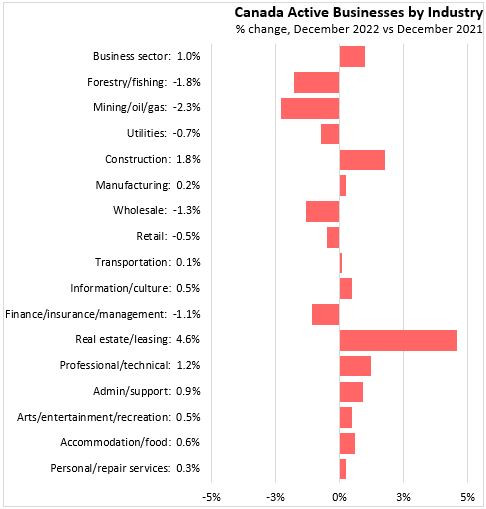
Statistics Canada has broken out specific data for tourism-related industries. Compared with December 2021, the number of active tourism-related businesses was up 1.4% in Nova Scotia as of December 2022, with a fall in recreation and entertainment. Travel services remained unchanged and transportation, accommodation, and food/beverages subsectors experienced gains.
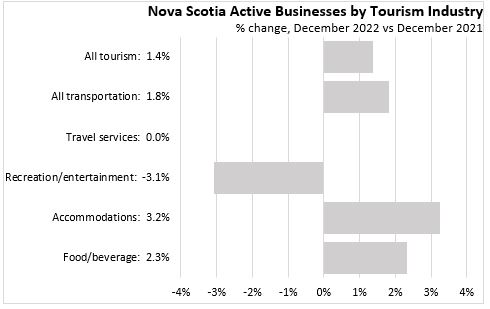
Nationally growth in tourism-related businesses was 0.4% over the last year with the only decline in transportation for tourism and stronger growth in travel services (which were down substantially during the height of the pandemic).
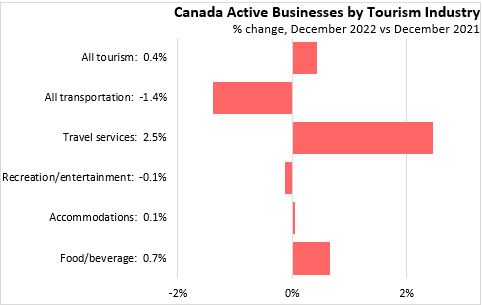
Trends
A business will be classified as 'opening' if it had no employment in the previous month and then has employment in the next month. A business is 'closing' if it had employment in the previous month and no employment in the current month. For opening and closing, the reason could be a permanent change (i.e. business exit) or temporary for reasons such as seasonal operations, capital maintenance or restructuring. Continuing business are those that had employment in both the current and previous month. Active businesses are the sum of continuing and opening business in the current month.
The rate at which business either opened, continued or closed can be examined to see how the number of active businesses has changed. The calculation for the opening, continuing and closure rates are based on the number of active businesses in the previous month.
Most businesses continue operating each month. In December 2022, Nova Scotia's business continuing rate was 95.8% (95.8% nationally). Quebec reported the highest business continuing rate (96.5%) while Prince Edward Island reported the lowest (94.1%).

Nova Scotia's business opening rate was 4.14% as of December 2022 (4.43% nationally). Prince Edward Island had the highest business opening rate (5.33%) while Quebec had the lowest (3.65%).

Nova Scotia's business closing rate was 4.33% in December 2022 (4.62% nationally). Prince Edward Island reported the highest business closing rate (5.57%) while Quebec had the lowest business closing rate (3.60%).
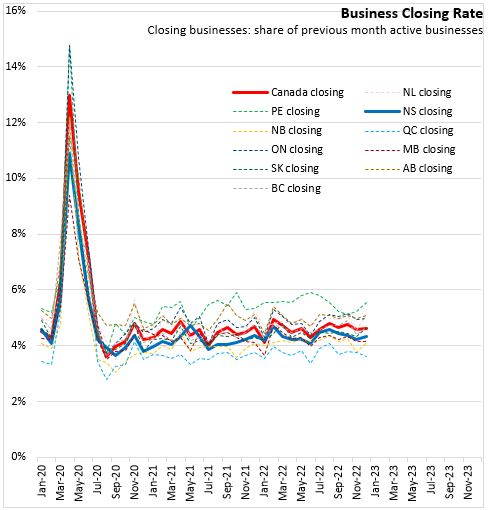
Personal/repair (-15), professional/technical (-7), and finance/insurance (-6) contributed the most to declining active businesses in Nova Scotia from November to December 2022.


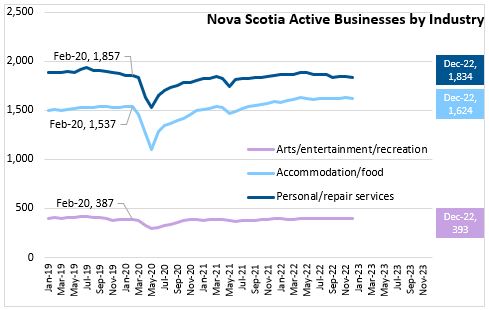
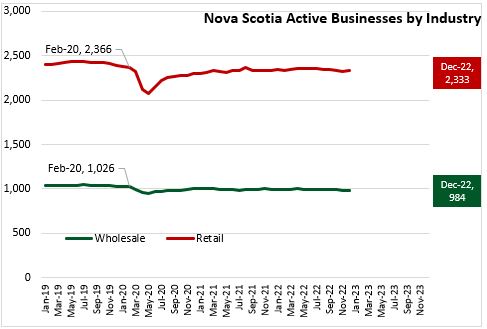

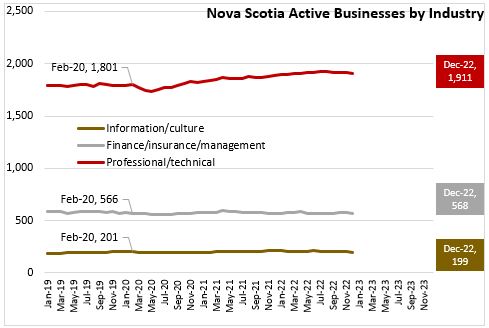

The source data is seasonally adjusted. The data may not aggregate due to firms being classified into multiple industry or geography.
Source: Statistics Canada. Table 33-10-0270-01 Experimental estimates for business openings and closures for Canada, provinces and territories, census metropolitan areas; Methodology: Business Opening and Closing